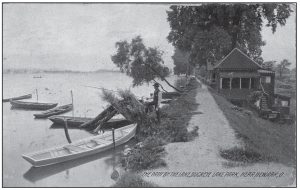
By 1894, railroad tracks had pretty much replaced the canals as the highways of civilization so the state legislature reserved the canal feeding “Licking Reservoir” as a public park to be known as “Buckeye Lake”. By 1906 stumps and logs had been cleared from some areas and the electric interurban was bringing people from Columbus for fishing and other recreation. One day in April of 1906 the Newark and Columbus newspapers proclaimed the formation of a yacht club. Interested people met first in Columbus and later in a house on Orchard Island to organize the club, to be named the Buckeye Lake Yacht Club.
By the middle of 1907, the new club had formed a building committee and taken over the lease on “Sunken Island”, a rise in the lake bottom sometimes entirely covered by water. A corporation was organized selling shares to finance the building of a clubhouse. Sketches of the proposed clubhouse were published in the newspapers. It was a rustic two story structure with steeply-pitched gabled and dormered roofs of wooden shingles. It had three separate porches facing west, south and north, the last of which extended to shore as a covered footbridge. High above the lofty rooftop stood a square tower, crowned by a lookout balcony facing all sides. Inside were a great-hall with inglenook and fieldstone fireplace, separate reception and retiring rooms, a single storied wing for dining and kitchen purposes and a locker room. Bids for construction were taken. But it was too expensive. So instead, they built a modest, small, two-story addition south of boathouses which lined the east side of the island. Construction was completed in 1907 and known as the BLYC “clubhouse”. It is now gone.
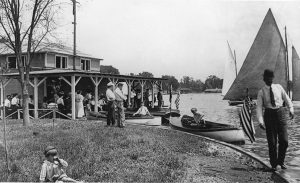
Membership grew, the building corporation continued to raise money and the island was filled in and raised and renamed “Watkins Island”, after the father of Buckeye Lake. In 1910 discussions continued on the construction of a “real” clubhouse. Harry Holbrook, a partner in the Columbus architectural firm of Dawson & Holbrook, became a member. Under his guidance a Clubhouse would surely be planned and erected.
A perspective by his firm, showing “Proposed New Quarters For Buckeye Lake Yacht Club”, was reproduced in miniature in The Ohio State Journal on Thursday morning February 29, 1912. That evening, the original of such drawing, and corresponding preliminary plans, were exhibited to members and guests at the Club’s Seventh Tar Social, again in the Ohio Club, for which the Hon. George J. Karb, mayor of Columbus, served superbly as guest-toastmaster.
The club’s governors, meeting shortly thereafter, received and adopted recommendations by a special ways-and-means committee to devise plans for raising funds to finance such a clubhouse. Prefacing its recommendations, this committee pointed out that construction of the building on Watkins Island would be the responsibility of Buckeye Lake Building Company, not that of Buckeye Lake Yacht Club; and that the Club itself, owning only about 160 shares of the approximately 500 sold by the building company, thus far, was not in a position to control the corporation. Furthermore, it was within the power of the company to sell any member or members of the Club any part or all of the nearly 500 shares still lying in its treasury. The situation also was complicated by the fact that a considerable number of individual stockholders no longer were members of the Club. Hence, it was not beyond the realm of possibility that control of the company and its property, and therefore that of the Club, could be manipulated out of the hands of the Club and its members into those of rank outsiders. To prevent such possible calamity, the Club itself would have to acquire a majority of the company’s total of 1000 shares of authorized capital stock. Facing such undeniable facts, the BLYC Governors immediately acted upon the committee’s recommendations.
The requirement of new members to purchase stock in the building company was abandoned; and the initiation fee was raised from $2.00 to $10.00. This made the total amount required of an applicant $14.00, including first year dues, instead of $16.00 as required formerly. The membership committee was instructed to wage an all-out campaign for additional members, on that more attractive basis, to bring enrollment up at least to 200. A new membership classification was established for “Life Members”, with limitation to a total of 50. Having paid a lump-sum fee of $75.00, such a member would be entitled to full privileges of the Club throughout the remainder of his life without further payment of dues. The Governors themselves would solicit such memberships. It was believed that this program, pursued with vigor, soon would make possible the Club’s assured control of the building company and, at the same time, provide funds for construction of the new clubhouse.
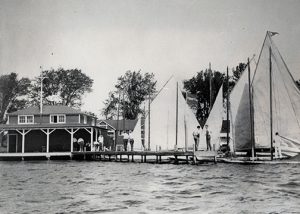
The Buckeye Lake Building Company, on March 23, 1912, had invested $4400.22, held 465 shares of treasury stock, had $19.87 in the bank, and owed $1000.00 on a mortgage held by Comm. Fred G. Speer. In its meeting of stockholders on that date, those present in person or by proxy represented 321 shares of the 535 which had been issued. Of such representation 163 shares were the property of BLYC, giving the Club itself a majority of 5 shares—sufficient at least to control the meeting.
The directors, meeting immediately, elected as the corporation’s officers, Pres. Reinmund, Sr., V. Pres. Speer, and Secy.-Treas. Freeman—an advantageous berth for BLYC’s commodore at that particular time. In this meeting, the secretary read a communication from Buckeye Lake Yacht Club. In effect, it stated that if the building company would erect a new clubhouse, the Club as such would subscribe and pay for the 465 shares of stock remaining in the corporation’s treasury; pay annual rental of $800.00 for use of the building company’s property, payable semi-annually on May 1st and November 1st of each year; and, upon completion of the building, make all repairs and pay for any alterations thereto. Acting upon a motion by Whitacre, the secretary was directed to notify the yacht club that the company directors approved such offers and would build a clubhouse costing in the neighborhood of $5000.00.
About three months later, on June 27, 1912, Mr. Whitacre presented to the directors of the building company, plans, specifications and estimates of cost for the proposed new clubhouse and necessary appurtenances. These having been discussed at length, a company committee, composed of Walter Whitacre, Harry Holbrook and John Maclean, was appointed to get the building built. This committee was authorized to proceed at once with construction of foundations, and to arrange for necessary materials and labor to erect the superstructure.
At this point, Harry Freeman not only was director and secretary-treasurer of the building company and commodore of the yacht club, but a real estate developer of considerable prestige; Whitacre was a director of the company, a governor of the Club and a lumber dealer of note, as well as chairman of the corporation’s building committee; committeeman Maclean was a company director, a past-governor of the Club, once chairman of its lake improvement committee, another lumberman and manufacturer of top-grade sash, doors and other millwork; and committeeman Holbrook was a member of the Club, a stockholder in its building company, and designing and supervising architect for the club-house—and nearly stone-deaf.
The new clubhouse, except for subdivision of most of its second story area, was substantially completed by the middle of February, 1913. In addition, the foot-bridge to the island had been rebuilt with steps up to and down from a middle section raised for passage below of craft without masts. On Sunday, February 22, 1913, a gang of clubmen celebrated Washington’s Birthday by donning overalls and mashing thumbs while constructing wooden walls, partitions and ceilings in the second story of the clubhouse, outside the previously built toilet room enclosure.
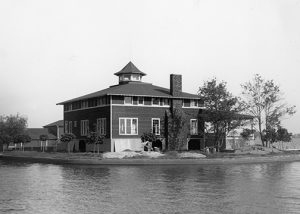
This structure, as taken over and completed by the Club early in 1913, was much as it exists today. Although the front porch originally extended beyond the main westerly wall, there was no glazed dining room or other structure back of it. Added later was the dining room addition along the west side, in which the chimney, originally on the exterior, can be seen. Also added later were additions on the north side to expand the kitchen and dining areas and the Commodores Lounge along the east side. “Ground Central Station” had not been developed. Upstairs, there were many small rooms for members use as sleeping rooms. These were later enlarged by consolidation to their current size. There was a broad hall under the cupola soon to be used as a billiard room. Billiard balls were all right in their place. But occasionally, in the still of the night, one at a time, they would roll down the stairs, Thump !-Thump !Thump! . . . to the disturbance of those in their sacks. Photographs, as well as stepping beneath the clubhouse, show that the island was later raised again, making the building and its front stairs a little shorter.
On March 31, 1913, the bilges of this brand-new clubhouse were awash. She was surrounded by nothing but air and water. Watkins Island had reverted, temporarily, to Sunken Island. The Club’s off-shore property was receiving its baptismal rite by way of near-immersion – the result of flood conditions then existing over much of Ohio’s Great Miami, Scioto, Muskingum and lesser southern river valleys.
Buckeye Lake Building Company’s stockholders in regular annual meeting, coincidentally on that same fateful date, represented 775 shares of the corporation’s authorized 1000 total. Of these, Buckeye Lake Yacht Club was owner of 663 shares. Thus, the Club not only controlled the meeting but had gained unquestionable control of and responsibility for the company and its, then, inundated and waterlogged property.
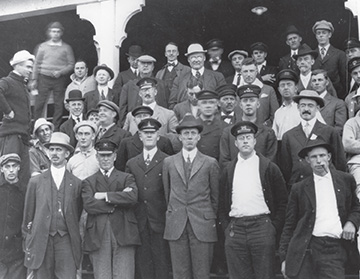
The clubhouse was officially dedicated in the semi-annual meeting on May 4, 1913—the first formal function held within its walls. Before the new clubhouse, off season activities had been limited to elsewhere than at the lake. Now social programs could be held at the club’s own facilities. Retiring the debt for the construction continued to be a problem. In 1917 the war absorbed members and income dropped. On Monday June 18, 1928 a tornado wreaked destruction on towpath property, filled the back channel with debris, removed roof covering from the clubhouse and removed most of the front porch above the floor. The inside was drenched. An assessment of members became necessary and was imposed.
Comm. Armstrong refers to Gov. Ed Wolfe [Comm. 1934] as fairly active, always loyal and the club’s true benefactor who had come to the aid of the club in times of real need. Comm. Lambrecht says that over the six years preceding and through Comm. Lambrecht’s term, he burned shares in the building company for each Commodore, the last being burned for Chris. Only Chris and Comm. Irwin knew of it. On November 28, 1938, with Chris Lambrecht as Commodore, the assets and liabilities of the building company were turned over to the Buckeye Lake Yacht Club, a quarter century after it was constructed. BLYC finally owned its clubhouse.

